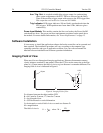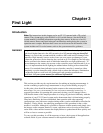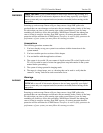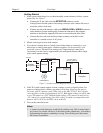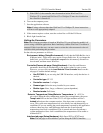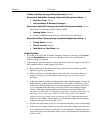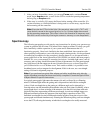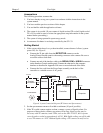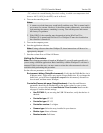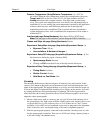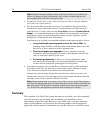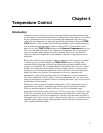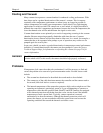
32 ST-133 Controller Manual Version 3.B
3. After you have focused the camera, you can stop Focus mode, continue Focus
mode, begin Acquire mode, or wait for the CCD to reach the operating temperature
before going to Acquire mode.
4. If the array is cooled by LN, empty the Dewar before turning off the controller. If a
coolant circulator or a chiller/circulator is being used to cool the array, stop the flow
before turning off the controller.
Note: Exposing the CCD to bright light (10× saturation) when cold (<-70°C) will
cause the dark current in the exposed pixels to be 3 to 10 times higher than normal
for that operating temperature. This effect is due to the formation of temporary traps.
The effect can be reversed by allowing the camera to warm up to room temperature.
Spectroscopy
The following paragraphs provide step-by-step instructions for placing your spectroscopy
system in operation the first time. The intent of this simple procedure is to help you gain
basic familiarity with the operation of your system and to demonstrate that it is
functioning properly. Once basic familiarity has been established, then operation with
other operating configurations, ones with more complex timing modes, can be performed.
An underlying assumption for the procedure is that the detector is to be operated with a
spectrograph such as the Acton SpectraPro
®
300i (SP300i) on which it has been properly
installed. See your system manual for mounting instructions. A suitable light source, such as
a mercury pen-ray lamp, should be mounted in front of the entrance slit of the spectrograph.
Any light source with line output can be used. Standard fluorescent overhead lamps have
good calibration lines as well. If there are no "line' sources available, it is possible to use a
broadband source such as tungsten for the alignment. If this is the case, use a wavelength
setting of 0.0 nm for alignment purposes.
Note: If you purchased an optical-fiber adapter and cable, install them only after the
regular alignment procedure has been successfully completed. Consult the Optical Fiber
Adapter manual for specific instructions.
In a typical spectrograph, light enters the entrance slit and is collected by a collimating
mirror. Collimated light strikes the grating and is dispersed into individual wavelengths
(colors). Each wavelength leaves the grating at a different angle and is reimaged by a
focusing mirror onto the intensifier photocathode at the exit focal plane. Essentially, what a
spectrograph does is to form an image of the entrance slit in the exit focal plane with each
position in the plane representing a different wavelength. As each wavelength images at a
different horizontal position, the spectrum of the input light is spread across the CCD.
Individual wavelengths focused at different horizontal positions along the exit port of the
spectrograph are detected simultaneously. Rotating the diffraction grating scans wavelengths
across the CCD, allowing the intensity at individual wavelengths to be readily measured.



